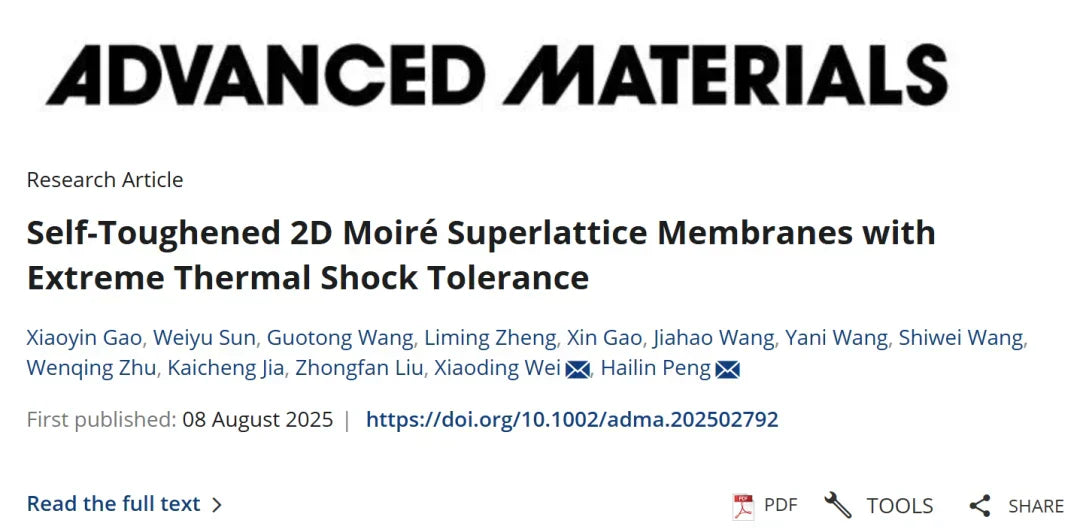Potassium metal batteries are considered one of the most promising candidates for next-generation energy storage systems due to their high energy density and fast ionic transport kinetics. However, their practical application is hindered by insufficient anode capacity and the uncontrolled growth of metal dendrites.
To address these challenges, the research team led by Academician Zhongfan Liu at the Beijing Graphene Institute (BGI) has developed a new approach to construct graphene–boron nitride (Gr–BN) heterostructures using a fluidized bed chemical vapor deposition (FB-CVD) process. Their work, titled “Turbulent Flow-Driven Synthesis of Graphene-Skinned Boron Nitride Heterostructures for Dendrite-Free Potassium Metal Batteries,” was recently published in Advanced Materials.
Innovative Approach
The team successfully realized uniform and thickness-controlled (5–90 layers) graphene coatings on hexagonal boron nitride (h-BN) powders, forming atomic-scale, van der Waals-coupled heterointerfaces.

Figure 1. Schematic of Gr-skinned h-BN@Al design & K deposition
Through computational fluid dynamics (CFD) simulations, the researchers revealed how turbulent flow inside the FB-CVD reactor regulates particle distribution and heat/mass transfer. Localized vortices effectively prevent particle agglomeration, enabling uniform dispersion of precursors and powders, thus creating ideal conditions for high-quality graphene growth. This fluid dynamics-guided synthesis offers a scalable and controllable route for producing heterostructure powder materials in bulk.

Figure 2. Simulated fluid behavior in the FB-CVD reactor and analysis of graphene growth quality under different gas flow velocities.
Material Characterization
Microscopic and spectroscopic analyses, including STEM, EELS, and XPS, confirmed that the synthesized Gr-skinned h-BN exhibits high crystallinity, low defect density, and clean interfacial coupling. The predominant sp² carbon bonding indicates well-preserved graphene lattice integrity.
When the Gr-BN powders were used to modify aluminum current collectors (denoted as GBN@Al), the surface energy increased to 43.27 mJ·m⁻², significantly improving potassium affinity and electrolyte wettability. The contact angle was reduced to only 14.7°, promoting layer-by-layer (Frank–van der Merwe) deposition of potassium and effectively suppressing dendrite formation.

Figure 3. Morphology, structure and characterization

Figure 4. Growth evolution with duration
Electrochemical Performance
The GBN@Al-based potassium metal anode demonstrated remarkable cycling stability, sustaining over 1,050 hours at a current density of 0.5 mA·cm⁻² with a low nucleation overpotential (<7 mV) and high Coulombic efficiency (99%).

Figure 5. Electrochemical performance comparison
Further analyses revealed that the modified current collector significantly lowered interfacial resistance and enhanced uniform ion transport, facilitating smooth potassium plating and stripping.
Significance and Impact
This work provides a new paradigm for scalable synthesis of high-crystallinity 2D heterostructures through fluid dynamics-driven process engineering. The integration of simulation and experimental validation elucidates how turbulent flow governs material growth at the microscale.
The resulting Gr-BN heterostructures exhibit excellent universality across different substrates, offering great potential for application in a wide range of advanced energy storage systems beyond potassium metal batteries.
Overall, this study not only advances the design of dendrite-free metal anodes but also highlights the unique advantages of FB-CVD for industrial-scale production of two-dimensional heterostructured materials.




Leave a comment
All comments are moderated before being published.
This site is protected by hCaptcha and the hCaptcha Privacy Policy and Terms of Service apply.